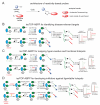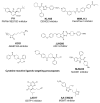Activity-based protein profiling for mapping and pharmacologically interrogating proteome-wide ligandable hotspots
- PMID: 27568596
- PMCID: PMC5305418
- DOI: 10.1016/j.copbio.2016.08.003
Activity-based protein profiling for mapping and pharmacologically interrogating proteome-wide ligandable hotspots
Abstract
Despite the completion of human genome sequencing efforts nearly 15 years ago that brought with it the promise of genome-based discoveries that would cure human diseases, most protein targets that control human diseases have remained largely untranslated, in-part because they represent difficult protein targets to drug. In addition, many of these protein targets lack screening assays or accessible binding pockets, making the development of small-molecule modulators very challenging. Here, we discuss modern methods for activity-based protein profiling-based chemoproteomic strategies to map 'ligandable' hotspots in proteomes using activity and reactivity-based chemical probes to allow for pharmacological interrogation of these previously difficult targets. We will showcase several recent examples of how these technologies have been used to develop highly selective small-molecule inhibitors against disease-related protein targets.
Copyright © 2016 Elsevier Ltd. All rights reserved.
Figures



References
Publication types
MeSH terms
Substances
Grants and funding
LinkOut - more resources
Full Text Sources
Other Literature Sources

